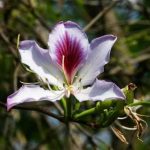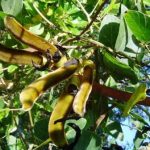TREE LIFE
May 2003
Subs for the year 2003/04 were due on 1st April. If you haven’t already paid please send your cheque for $1500 as soon as possible.
WHILE THE CURRENT FUEL CRISIS PERSISTS IT IS IMPORTANT TO CONFIRM WITH ANY OF THE COMMITTEE MEMBERS THAT THE SCHEDULED OUTINGS AND WALKS CAN ACTUALLY TAKE PLACE. SEE THE BACK PAGE FOR PHONE NUMBERS.
MASHONALAND CALENDAR
Saturday 3rd May: Botanic Garden Walk with Tom Müller. Meet in the car park at 10.45 for 11am. The interesting subject of Acacias continues.
Sunday 18th May: The AGM will be held at the home of Rob and Gillian Smith at No. 3 Farnborough Close in Greystone Park.
Tea and coffee will be served at 9.30 and the meeting will start at 10am. Please bring, if you can, a plate of eats to share and a chair. After the meeting Rob and Gillian will show us the huge collection of indigenous trees planted and doing very well in their garden, which is where we can also enjoy our lunch.
Saturday 24th May: Mark’s Walk will be to Mr. Hatendi’s property Charmwood. Meet at 2.30pm.
Saturday 7th June: Botanic Garden Walk.
MATABELELAND CALENDAR
Nothing has been arranged for May.
BOTANIC GARDEN WALK: 1 APRIL 2003
We just made double figures for this walk (that is including Tom in the count), and the subject was the acacias which we have looked at several times before. But the local acacias are diverse enough to provide us with something new and interesting facts on every visit we make to them.
The genus Acacia in Zimbabwe can be divided into two groups (subgenera), i.e. Group 1, those with hooked thorns, and Group 2, those with paired straight thorns (spinescent stipules). Species belonging to Group 1 usually have their flowers in spikes, but there are three exceptions which have globose flowers. Group 2 species all have globose flowers. The hooked thorns or prickles of Group 1 species are superficial (part of the bark), and can be broken off like rose prickles; they may be paired or in 3s just below the nodes, or scattered along the branches.
All acacias have bipinnate leaves, and the numbers of pinnae and leaflets are characteristic of a particular species. On this walk we looked specifically at acacias with hooked thorns, except for one digression to examine a species from Group 2.
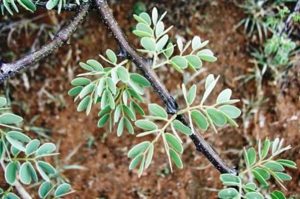
Acacia mellifera ssp detinens. Photo: Sheila Gregory. Source: Flora of Zimbabwe
Our first species as Acacia mellifera ssp detinens (blackthorn) This characteristically has 2-3 pairs of pinnae per leaf, with 1-4 (usually 1-2) pairs of leaflets. The thorns are in pairs, dark brown or black, and particularly vicious (detinens means detaining or holding back). The flowers are essentially in spikes, but may appear to be in balls, and are sweet scented (mellifera means honey-bearing). This is a species of the west and north of Zimbabwe, essentially dry country, and is usually a shrub, but may be seen as a small tree with a wide crown.
Acacia erubescens (bluethorn) is a small, straggly tree from dry country, often found on basalt hills in the west, southeast, and north. The hooked thorns are paired, and the leaf characteristically has quite a short rachis but 3-7 pairs of long pinnae bearing around 14 (10-30) pairs of leaflets. The bark is papery and flaky.
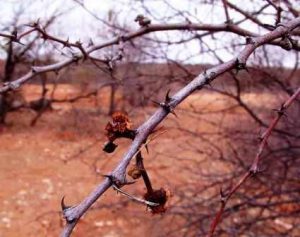
Acacia senegal var leiorachis. Photo: RobBurrett. Source: Flora of Zimbabwe
Acacia senegal var leiorachis (slender three-thorned acacia) has hooked thorns in 3s. It is generally a slender tree up 8 m tall, but the specimen we saw was atypical, being squat and low-spreading. The bark is yellowish and peels in papery strips. This is one of the acacias that produces gum arabic. Its distribution in Zimbabwe is in the extreme southwest, southeast, northwest and northeast. The other supposed variety, A. senegal var rostrata (bushy three-thorned acacia) is confined to the south, southwest and southeast of the country. It does not have flaky bark, and other anatomical features are so different from var leiorachis that the two should really be considered separate species. Many botanists believe that var leiorachis is too different to be part of Acacia senegal.
Acacia burkei (black monkeythorn) was next on the list. This is an ill-defined species from the Cretaceous sands of Gonarezhou in the extreme southeast, and is part of a complex comprising A. nigrescens, A. burkei, A. goetzei, and A. welwitschii, and the suggestion seems to be that these may be geographical (?clinal) variants of a single species. The key character in A. burkei is the hairy calyx. It is a large tree, reaching 30 m in height, with leaves bearing 4 (3-13) pairs of pinnae, each with about 5 (4-19) pairs of leaflets. The thorns often persist on the trunk.
Acacia eriocarpa (woollypod acacia) is a multi-stemmed shrub or small tree from the Zambezi valley. It has scattered thorns and is the only one of this group to make tree size. The leaves are fairly large, each bearing up to 9 pairs of pinnae with up to 15 pairs of leaflets. The pod, as the common name implies, is covered in woolly hairs.
Acacia hereroensis (arid hookthorn, or redthorn) has paired thorns at or below the nodes, but they may sometimes be scattered. It is a shrub or small tree with a very narrow distribution in Zimbabwe between Bulawayo and the Matopos, but a small population of 8 plants has been recorded from the Marlborough Vlei in Greater Harare. This is a dry-country species, with the greater part of its range in Namibia, so the Harare population seems too anomalous to be natural. The leaves may bear up to 20 pairs of pinnae, each with 30 or more pairs of very small leaflets.
We had to hunt a bit for the next species, Acacia fleckii (bladethorn), which is distinguished from A. erubescens by its much shorter petiole, the presence of a large petiolar gland, and the absence of glands between the pairs of pinnae. Bladethorn has up to 20 pairs of closely spaced pairs of pinnae, each with up to 30 pairs of very small leaflets. The bark peels from the branches, especially on the shrubby specimens. The origin of the English name bladethorn escapes me, unless it refers to the straight pods.
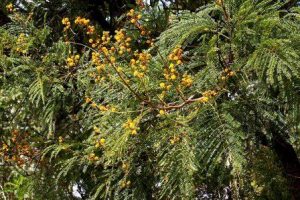
Acacia amethythophylla. Photo: Bart Wursten. Source: Flora of Zimbabwe
Then there was a digression from hook-thorned species to have a brief look at Acacia amythethophylla (largeleaf acacia). No doubt this species, which has the largest leaves of all our acacias, will be dealt with fully when its turn comes round, but the thing that really intrigued me about it was the different ways the specific name was pronounced. I know that botanical Latin (or Greek) often has its own pronunciation, but my instinct is to say amy-THETH-o-PHYLL-a on the grounds that the name is derived from two separate words amuthos and phyllon, and I had difficulty in getting to grips with amythe-THOPH-ylla, where the accent is on the last half of the first word and the first half of the second. This reminds me of a visit to Alice Springs in Australia, where, among other species, I was shown an interesting mallee eucalypt, Eucalyptus gamophylla (blue mallee), in which the pairs of juvenile leaves are fused together at their bases. The name gamophylla is derived from the Greek gamos (marriage), and phyllon (leaf), and refers to this union. Again, my instinct is pronounce the name gamo-PHYLL-a, with the accent on the third syllable, but my Australian guide insisted on calling it ga-MOPH-ylla, accenting the second half of the first word and the first half of the second. Am I missing something?
However, back to the purpose of this note.
Acacia welwitschii ssp delagoensis (Delagoa hookthorn) is a stately riverine tree with a restricted distribution in the Chiredzi district. One of the main characters separating it from A. burkei is that it is completely glabrous, whereas the latter has leaves and growing tips that are velvety-hairy. There are other differences of leaf size and shape between the two, and opinion suggests that A. welwitschii is a well-defined species.
Next, we saw Acacia goetzei ssp goetzei , which is widely distributed in Zimbabwe, but is absent from the southern third (or quarter) of the country. This is a woodland species and so variable that it is difficult to separate it clearly from other species in the burkei-goetzei-nigrescens-welwitschii complex. We also saw A. goetzei ssp microphylla, which has much smaller leaflets.
Finally we examined Acacia nigrescens (knobthorn), so well known in mopane country. It may be a tall, erect tree with a rounded crown, and it has leaves with 1-3 pairs of pinnae, each with only 1-2 pairs of leaflets, the largest leaflets of any acacia in Zimbabwe. But often the most striking character is the presence of numerous, large, spine-tipped bosses on the trunk, from which the species derives its English common name.
Our thanks to Tom for a very interesting return to the acacias, and we must hope that next month’s session will see a larger gathering of members to share his knowledge of this important and diverse group of trees.
-Lyn Mullin
“Make Thee an Ark of Gopher Wood” Genesis 6:14
TREE LIFE No 276 carried an interesting article on gopher wood, and I happened to have some additional thoughts on the subject, which are given below:
Gopher wood is mentioned only by the Authorized (King James) Version (AV), the Revised Version (RV), the Revised Standard Version (RSV), the New King James Version (NKJV), and The New American Bible (NAB), and only in Genesis 6:14 (NAB and NKJV have it as one word, gopherwood). It has been taken directly from the Hebrew gopher, suggesting that the translators rather skirted round the problem of identifying it! Gopher is derived from a root word probably meaning “to house in”, and has been interpreted as a kind of tree or wood (as used for building), apparently the cypress (James Strong, 1950, Exhaustive Concordance of the Bible ). It is assumed by many commentators that gopher wood is a coniferous timber-cedar, pine, juniper, or cypress-and this view seems to be endorsed by the majority of the English versions of the Bible considered here. Gopher wood is rendered as “cypress” by the New Revised Standard Version (NRSV), New English Bible (NEB), Revised English Bible (REB), New International Version (NIV), and James Moffat (MFT), and as “resinous wood” (implying a coniferous wood) by The Jerusalem Bible (JB), The New Jerusalem Bible (NJB), and The Living Bible (LB). Other English versions have “pitch-pine” (Ferrar Fenton, FTN), “good timber” (Good News Bible, TEV), “planks of wood” (Knox, KNX), and “timber planks” (Douay Version, DV).
However, if cypress is, indeed, the correct interpretation, one might have expected gopher to have appeared elsewhere in the Hebrew Bible. Apparently it does not, and some of the speculation about what wood was really meant is recorded in the following extract from E. Cobham Brewer (1906) Dictionary of Phrase and Fable–
Gopher wood of which the ark was made.
It was acacia, says the Religious Tract Society.
It was boxwood, says the Arabian commentators.
It was bulrushes, daubed over with slime, says Dawson.
It was cedar, says the Targum of Onkelos.
It was cypress, says Fuller.
It was ebony-wood, says Bockart.
It was deal or fir-wood, say some.
It was juniper-wood, says Castellus.
It was pine, say Asenarius, Munster, Persie, Taylor, etc.
It was wicker-wood, says Geddes.
All of the coniferous options in the Bible lands seem to have been catered for here, and while it is known that the Targum of Onkelos (more correctly Onqelos) is a paraphrased Aramaic translation of the Old Testament, supposedly produced by a 1st Century AD proselyte named Onqelos, one is left wondering who, or what, were the Religious Tract Society; the Arabian commentators; Dawson; Fuller; Bockart; some; Castellus; Asenarius, Munster, Persie, Taylor, etc; and Geddes!
-Lyn Mullin
MSASA MOTH, PACHYMETA ROBUSTA.
The larva are a common sight in Brachystegia woodland on both Msasa and Mnondo and cluster together on the trunks of trees forming orange hairy mats. The caterpillar is large and spectacular and bears black spines. The caterpillars disperse at night to feed on the leaves.
The moth belongs to the family Lasiocampidae which includes the Lapped and Eggar moths. The female is a large stout moth with densely scaled wings. The forewings are narrow with brown and grey markings. A dark brown band crosses the forewings vertically. The forewings and thorax are greyish and the abdomen and hind wings are light brown., The adult stage does not feed.
The caterpillars spin large robust cocoon.
The empty cocoons of some Lasiocampids are so large that they can contain small stones and be used as anklets for performing traditional dances in some parts of Africa. The genus Gonometa is recorded as being a particular nuisance because if cattle browse on bush in times of drought and swallow the cocoons the silk is not digested but unravels in the rumen clogging with the food forming great lumps. If these obstructions are not removed surgically the animal will die.
MOPANE WORMS.
THE EMPEROR MOTH, GONIMBRASIA BELINA
These are not worms but caterpillars of a magnificent Emperor moth belonging to the family Saturniidae and are the biggest moths many have wing spans in excess of 100 to 200mm. Most are recognisable by the large ringed eyespots in the hind wings. This is a protective mechanism because if displayed looks like a large animal to a would be predator. The moth is very common and often found inside after dark when it is attracted to light.
The male moth has the feathered antennae.
The caterpillar known as the Mopane worm feeds on Carissa, Terminalia and other trees. The caterpillars
are large and juicy and are about 55mm, and are highly nutritious. The caterpillar is banded in green and light green and has rings of small blackish spines.
The caterpillar is dried and sold in the Mbare Msika where I have seen it piled on pieces of newspaper or in empty baby food ‘Purity’ jars. About fifteen years ago Mopane worms were canned in small tins. The cooking process rendered the caterpillar smaller and brown and a bit soggy and not resplendent of its former majestic glory. Gonimbrasia is the ambrosia of people both in the Northern Transvaal and Zimbabwe where it is considered a delicacy.
-Mary Toet
THE AUSTRALIAN BAOBAB
A photocopy of an article by Charles H. Doherty on the Australian baobab has recently come to hand. It was originally published in July 1966 in the Bulletin of the International Wood Collectors Society, Volume 19, No. 7, and it provides an interesting supplement to recent articles on baobabs that have appeared in TREE LIFE. It is reproduced here with minor editing.
A remarkable feature of the northwest landscape, and limited to this part of the continent, is the baobab, Australia’s most grotesque tree. Better known as the bottle tree, its name is derived from the tremendous swelling of the trunk, like a huge bottle. This is nature’s adaptation to austere conditions, providing the tree with internal storage for food and water against long periods of drought. Some of the trees are as wide as they are high, and each yields many gallons of drinkable water from the base of every branch. The trunk produces a nutritious, gummy substance, often eaten by the Aborigines. In the spring the trees clothe themselves with graceful yellow blossoms, rather like those of a cactus. The scent of these flowers is beautiful-a soft, enveloping fragrance that haunts the senses.
When Captain George Grey was exploring northwest Australia, more than a century ago, he observed “a gouty-stemmed tree, which appeared to be suffering from some disease”. Later, his report further states, hundreds more were seen, “all affected in the same way”, and it was then realized that these huge swollen trunks were normal.
Some of the baobabs may be 40 feet [12 m] high, though they are usually of lesser height, while the girths of some trees have been measured at nearly 60 feet [18.3 m in girth, or 5.8 m in diameter]. No two trees are alike; some are, in a way, almost graceful, with tall swollen stems, others squat and gouty-looking. Often growing singly or in small groups, there are times, however, when they are thick enough to form what could almost be called forests.
Even when very young, the bottle tree shows its peculiarity, becoming swollen-stemmed; later, as the spongy trunk lengthens, it widens out as well, until a tree 25 feet high [7.6 m] may measure some 30 feet [9.1 m] in girth [3.1 m in diameter]. Elliptical in form, and about the size of a small melon, the fruit of the baobab is enclosed in an almond-like rind; the shell is full of soft white pulp, in which the seeds are embedded. Elegant ornaments are made from these “nuts”, and many a native exhibits his natural artistry in aesthetic designs carved and painted in the woody skin of the baobab fruit. The wood of the tree is too soft and spongy to be of much practical use.
The explorer Gregory carved the date, July 2, 1856, on the trunk of one of these trees growing on the banks of the Victoria River. Today the lettering is perfectly preserved, affording clear evidence of the ripe old age of the tree, for it would probably have been at maturity even then. Gregory’s marked tree may well be centuries old. This Australian explorer was possibly the first white man to discover the bottle tree, since the coming of the first colonists some 70 years before. Later it was named Adansonia gregorii in his honour, and took its place in scientific literature as one of the world’s most remarkable trees.
This might be a good place to add that the tree commonly known as the bottle tree is southeastern Queensland, its only area of occurrence, is Brachychiton rupestris, whose trunk is indeed shaped like a gigantic bottle. But the whole tree, “bottle” and all, is much more graceful and symmetrical in outline than the baobab, and besides, possesses a fine dense head of bright green foliage. Furthermore, although like the baobab it is a useful fodder tree for stock, it is not a source of drinkable water.
Botanical textbooks usually contain all the common vernacular names of the trees described, but no reference is made to the baobabs as “prison trees”. Yet many of them are known as such in the northwest. The prison trees are those actually used as cells, in which Aborigines who offended against the white man’s criminal code were locked up while being brought to trial. Few of the remote police stations in this part of Australia possess lock-up accommodation. Even today a constable has no alternative but to make his captive fast to a tree during resting periods while taking him on the long journey to town. It was found that the big baobabs made convenient lock-ups. The massive stem is often hollow, and it needed little chopping to cut a doorway through the fibrous wood and so convert a tree into a cell. Disused prison trees, all baobabs, are scattered in different parts of the northwest. One in the Derby district has a hollow interior that affords accommodation for a dozen prisoners without overcrowding. Its ceiling is about 18 feet [5.5 m] from the ground, and, apart from the entrance opening, there are two apertures for ventilation. Another prison tree near Wyndham is said to have housed as many as 18 prisoners at a time. There was little chance of the captives escaping for the walls of the tree are 2 feet thick, while the entrance itself had been fitted with an iron grille. This particular tree was first used as a lock-up in 1900, and its outer shell is carved liberally and deeply with dates, names, and initials of troopers, along with broad arrows and other marks of northern patrols. The markings have generally been made with tomahawks or knives, but one individualist has left his initials in the form of rifle cartridges hammered into the trunk.
[Comment: This last-mentioned act had been done before-at Tuli in 1890 by members of Rhodes’s Pioneer Column. Either human endeavour doesn’t change much across the continents, or the man responsible for the artwork in northern Australia had been a member of the Pioneer Column!]G.M. Glasking, in his book The Land That Sleeps, gives us a quaint description of his first impressions of a group of baobabs, together with a few facts, in the following extract:
“Had I driven with Paul from Broome to Derby, instead of flying in from Darwin, I would have seen the baobabs, or bottle trees, much earlier. But we had driven only a few miles from the town when they began to appear, at first in just ones or twos here and there, then in clumps, and even in what I suppose was a near approach to a forest.
“I should think these trees are the most unique species in the world. They are certainly among the most ungainly in appearance. Their trunks are huge bloated affairs, many times the girths of other trees, with heights that appear to range anywhere from 30 to 50 feet [9-15 m]. Nearly all of this is trunk. The branches, with their sparse foliage, sprout from the top, much as if they were a few random twigs placed by a child in an over-large bottle. The average tree has a trunk of 10-15 feet [3.0-4.5 m] in diameter, but there is the occasional old-timer that is more capacious still.
“In times of drought the trees have been felled to feed cattle, the bark being then cut off so that the stock can eat the moist pulp. Bottle tree, therefore, seems to be a doubly apt name for them. And yet, had I not known the tree’s nickname, I think I would have called it the “dancing fat lady” tree, for they looked like very fat and perhaps slightly intoxicated ladies, lurching and lumbering through the bush toward the road, as though about to wave for a lift, some appearing to lunge at awkward angles, others arrested in a tottering gait as though their weight were difficult to manage on small feet and high heels. They are essentially comical trees-incongruously comical.
The late afternoon sun washed them in golds and pinks, and made them look all the more like great fat ladies, but now all dressed up in evening frocks of gold lamé or pink satin, as though off-some well-whiskied and others gently ginned-to the terpsichorean adventures of a local dance. Even their mere twigs of branches and foliage simulated jewellery and decorative plumage worn as headdress. Paul and I spent some time observing the fat and slightly tipsy ladies, and soon noticed they had acquired personalities of their own. And with these personalities it was a matter of only a few more moments before we decided they must have names. So, giving our faculty’s full reign, we named them-
Sadie, Myrtle, Li, and Nell!
‘How are you, girls?’
‘Oh, we’re all swell!’
Lily, Daphne, Jess, and Dawn,
Off to dance with their skirts all torn.
‘I’ve got whisky, and Sadie’s got gin,
So we’re off to find a bit of sin!
We’ll dance until our feathers fall,
So come on girls, let’s have a ball!’
“Shrieks and titters, laughter lewd! And some of their shouts sounded downright naughty! I could have sworn it all came from my wonderful fat ladies of the bush, though of course the sound effects were provided by only the local birds, especially the parrots. In Australia the baobabs are not known as dancing fat ladies, but only as bottle trees. Such a pity, as what a wonderful danse macabre they would make for another Disney “Fantasia”, accompanied, perhaps, by the first movement of Katchaturian’s piano concerto.” End of extract.
Lyn Mullin
DODO ECOLOGY
“The Dodo,” wrote the humorist Will Cuppy, ” seems to have been invented for the sole purpose of becoming extinct, and that was all he was good for.” Not so. That large (25 to 50 pounds), ill-favoured, flightless Raphus cucullatus of the island of Mauritius in the Indian Ocean, also known as Didus inneptus and dubbed doudo (silly) by the Portuguese sailors who discovered it in 1507, that slow-moving member of the pigeon family whose name became a byword for stupidity and failure to adapt (the last dodo had succumbed to man and his domestic animals by 1681), was apparently indeed good for something else. It played an essential role in the life cycle of a large tree, Calvaria major. Absent the dodo, Calvaria seeds have apparently not germinated for nearly three centuries, and the tree is now nearly extinct – going the way of the dodo.
That is the conclusion of Stanley A Temple, an ecologist at the University of Wisconsin, who reports on the interaction of R. Cucullatus and C. major in Science. The tree was once common in the forests of Mauritius, Temple points out, but by 1973 only 13 old and dying specimens were known to have survived, each of them estimated by foresters to be more than 300 years old. The survivors produce well formed fruits, but the seeds do not germinate even under nursery conditions. The reason appears to be that the seed is enclosed in an extraordinarily thick (up to 15 millimeters) endocarp, or pit, that keeps the embryo from expanding. Noting “the temporal coincidence between the extinction of the dodo 300 years ago and the last evidence of natural germination of Calvaria seeds,” Temple hypothesized that a period of co-evolution had led to a “mutualistic” relation between the tree and the bird. He proposed that the thick endocarp was evolved by Calvaria in response to the destruction of its seeds by the fruit-eating dodo; the tough pit resisted destruction by the large stones grinding away in the dodo’s powerful gizzard, but the gizzard did abrade and scarify the pit enough so that when it was excreted, the seed could break through and germinate.
Temple calculated the forces likely to have been generated in dodo’s gizzard. He found that intact pits could indeed have withstood such forces without being crushed; the pits would not have been crushed until after they had been abraded to a size at which they would be likely to be excreted. He tested his hypothesis by feeding fresh Calvaria pits to turkeys. Of 17 ingested pits, seven were eventually crushed in the turkey’s gizzard and 10 were regurgitated or excreted after being reduced in size by abrasion. When he planted the 10 pits, three of them germinated.
They “may well have been the first Calvaria seeds to germinate in more than 300 years.” Temple points out that many instances of plant-animal mutualism are known in which the elimination of a plant species has affected an associated animal population. This appears to be the first documented example of the reverse.
Reproduced with acknowledgements to Trees in South Africa Apr-June 1978 and Scientific American Inc.
SNIPPETS.
Combretastatin A4 is the name of a chemical derived from Combretum caffrum, which is reported by scientists of the British Cancer Research Campaign, Northwood, London, as having impressive powers of killing tumours. The chemical, which can be synthesized, has a dramatic ability to shut down blood vessels supplying oxygen and nutrients to cancerous tumours, thus causing them to starve. Combretastatin appears to affect only tumour blood vessels and to leave healthy veins and arteries untouched. The drug did not kill all cancer cells in the laboratory trials on a range of different organs’ cancers so far conducted because the rim of the tumours was fed by normal blood vessels, but these could be dealt with using conventional therapy.
The drug was supplied to the British researchers by its discoverer, R. Pettit of Arizona State University.
(Verbatum from the Commonwealth Forestry Review 76(2), June 1997)
Comment: Combretum caffrum (Cape bushwillow) comes from the Eastern Cape and Transkei. It closely resembles our own C. erythrophyllum (river combretum), which is widespread in much of Zimbabwe, and southwards through Transvaal, Natal, and Northern Cape. Perhaps C. erythrophyllum should be investigated for a similar chemical.
-Lyn Mullin
FLORA OF ZIMBABWE WEB SITE
I have created a web site devoted to the Flora of Zimbabwe at https://www.zimbabweflora.co.zw/. The main content of the site at the moment is a searchable checklist of Zimbabwean vascular plants, which gives the Latin names and authorities, the Flora Zambesiaca divisions in which the taxa occur and the sources of that information. After passing through a number of drafts, the checklist has now reached temporary stability at version 1.0. Further higher-numbered editions of the checklist will be created as errors are corrected, taxonomic change occurs and further information comes to light.
I hope to extend the site in future to include further information such as local checklists and photographs of plants.
-Mark Hyde.
NOTHING TO DO WITH TREES (With apologies to Rudyard Kipling)
If you can be cheerful, ignoring aches and pains,
If you can resist complaining and boring people with your troubles,
If you can eat the same food every day and be grateful for it,
If you can understand when loved ones are too busy to give you time,
If you can overlook when people take things out on you for something that has gone wrong through no fault of yours,
If you can take criticism and blame without resentment,
If you can face the world without lies or deceit,
If you can conquer tension without medical help,
If you can relax without liquor,
If you can sleep without the aid of drugs,
Then you are probably a cat or a dog.
(excerpt from a pew leaflet, Catholic Cathedral, 25 August 2002)
MARK HYDE CHAIRMAN


